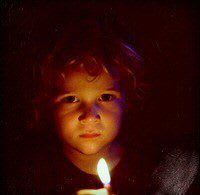There is an intimacy about James' story and Britten's opera that makes it an obvious choice for this Up Close venue. There is no chorus to crowd the stage, just six soloists, though they are not roles that are easy ones to cast since two of them are children: this is a story of ghosts and child corruption.
It is a score full of atmosphere, of emotive and descriptive colour that, though written for a chamber orchestra uses percussion, strings, woodwind, horn, harp and a celesta. Here it is given in an arrangement for piano, but musical director David Easton performs it splendidly. Yes, there is a loss, but the musical ideas come through and only at moments is one made aware of it as a piano reduction. It is well sung too, though stronger on emotion than it is on diction. High soprano lines are never easy to make clear but there was more lost than there should have been.
The children are sung by real children, not just Samuel Woof, the boy soprano Miles I saw (sharing the role with Saul Friend through the season) but by Eleanor Burke (still at school) whom I saw as Flora (a role she shares with Skye Houston). Against the full adult voices Miles specially was sometimes a little too small even in this compact venue but he made up for it in his performance.
Designer Signe Beckmann has put this Victorian tale into modern dress. Miles has a Superman tee-shirt and housekeeper Mrs Grose (Laura Casey) sips what could be a smoothie through a straw, David Menezes's Peter Quint is a raunchy seducer in a leather jacket bibbing wine and Catrine Kirkman a slinky Miss Jessel in an evening dress and earrings for the strange "Colloquy" with which the two ghosts open the second act. While leather works as a symbol for sinister Quint, her dress, though it might work in this scene, set in some ghostly place, is hardly an image that suggests the country governess.
Beckmann uses Richard Bloomsdale's video graphics projected on her ceilinged plain white set to create atmosphere and location but their shadows, clouded skies and the bobbing leaves or dabbling ducks on water ripples (and later some abstract patterns) rarely suggest any very positive location and atmospheric effects depend more on the contribution of Richard Howell's lighting, though when the ghosts first appear they are perhaps too weakly lit for all the audience to register their presence..
Director Edward Dick has imposed his own frame upon the piece. He begins with Katie Bird's emotional governess on the floor, grappling with one of the two plain wooden chairs that provide furniture and a raised position. The singer of the prologue walks around her setting up the story of her being engaged by the children's uncle to be their governess in remote Bly House and the instruction he gave her never to bother him or to inquire about the history of the place. He then describes her journey there, the music giving us horses and a jostling carriage but he simply seats her on a chair.
For all the transitions between the following sixteen scenes Britten has provided an interlude to cover scene changes (though in fact in the original production these were mainly a gauze drawn partway across the stage to cover or reveal any scenic items and Michael Northen's lighting). Dick has filled almost all of them with action to extend the closing of one scene and the opening of the next, a business that sometimes works but that distracts from the way in which these sixteen interludes, which are all written as variations on the twelve-note main theme of the opera, establishes the emotional transition and the new location.
When the second act opening changes to a churchyard scene the suggestion of church bells in the score is rather lost in this in this arrangement and with no help from the design it rather weakens the impact of their seemingly devout singing actually being what Mrs Grose calls obscenities.
The music does so much of the work in this opera and Dick spoils an emotionally strong performance from Katie Bird by making her sometimes rush around the stage to express her agitation. On this small stage it looks especially awkward; stillness which allowed us to share her feelings would be much more effective. For me he has totally mismanaged the plaintive ending. This highpoint of the opera where the struggle between the Governess and Quint reaches its climax, he has her and Miles on the floor, masked for most of the audience by the heads of the front row, then has dead Miles get up, pick up a chair and walk off while a white coated nurse appears in a doorway and the singer of the prologue reappears and we now see him as the psychiatrist in a mental institution who has been presenting the mental traumas and possible delusions of his patients. It is busy where it requires stillness, the drama carried in the final notes of the opera, originally played by that fine percussionist James Blades using his fingers on the skin of a large drum.
Perhaps I am prejudiced: I had the good fortune to work on the original production of The Turn of the Screw and it would be difficult to entirely please me! But the musical side of this production and the integrity of the performers still demonstrate how great a piece this is and at times I found it had the same intimacy I remember from watching it in rehearsal or seeing it from the prompt corner.
"The Turn of the Screw" is in repertoire at the Kings Head Theatre until 20th August 2011.
